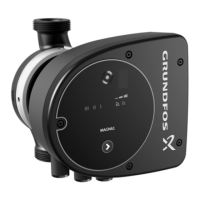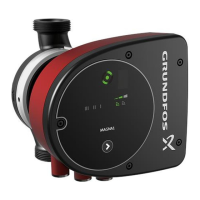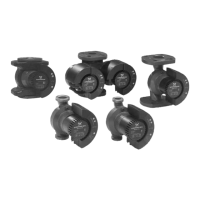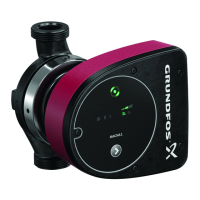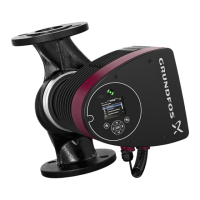System applications
MAGNA3
3
10
Main pumps
Due to variations in the heat demand and flow rate, we
always recommend that you use speed-controlled
MAGNA3 pumps in a heating system, either
single-head pumps connected in parallel or twin-head
pumps. Single-head pumps connected in parallel have
several advantages. In alternating operation, each
pump is sized for 100 % flow. In this operating mode,
the second pump functions as backup for higher
reliability. As the pumps alternate, an equal number of
operating hours is ensured. Cascade operation of
pumps connected in parallel meets demands in
high-flow systems with low differential temperature
(∆t), and 50 % backup is ensured at the same time.
The twin-head pump saves installation time and costs.
By speed-controlling all pumps, you can obtain
maximum energy saving as the pumps will run at their
best efficiency point (BEP).
In a variable-flow system, we recommend that you
control the main pump in AUTO
ADAPT
or proportional-
pressure mode.
However, if a load (e.g. a radiator) is far from the
pump, it can be advantageous to install a differential
pressure sensor across this load and use a setpoint for
differential pressure.
By using the FLOW
ADAPT
function to ensure correct
balancing of the system, the need for pump throttling
valves can be reduced significantly.
The built-in heat energy monitor allows monitoring of
the heat energy consumption in the system only for
optimization purposes.
Air handler heating coils
The performance of heating surfaces is controlled by
the heating-water temperature and the flow rate. For
this purpose, we recommend that you install
variable-flow mixing loops at the heating surfaces. A
speed-controlled mixing-loop pump is ideal for
adaptation to the varying loads in a heating surface. In
this case, MAGNA3 will have full authority, making
external pump throttling valves superfluous.
Domestic hot water
For domestic hot-water circulation, the
constant-temperature control mode will ensure a
constant temperature in the recirculation pipe, without
the use of separate thermostatic valves, thus obtaining
maximum comfort.
Mixing loops
Due to variations in use, flow-pipe temperature and
heat demand in different parts of the building, the
heating system must be divided into zones controlled
by independent mixing loops. Due to the flow
variations, a speed-controlled mixing-loop pump will
have authority in the system. This will help obtain a
better hydraulic balance in the overall system. Speed
control of the pump via selection of a control mode,
depending on system application, ensures maximum
energy saving. See Control modes, page 17.
Advantages of using mixing loops:
• Reduced excessive differential pressure in the
system and hereby reduced risk of overflow
• increased control ability as the loop is provided with
the exact flow rate and temperature demand.

